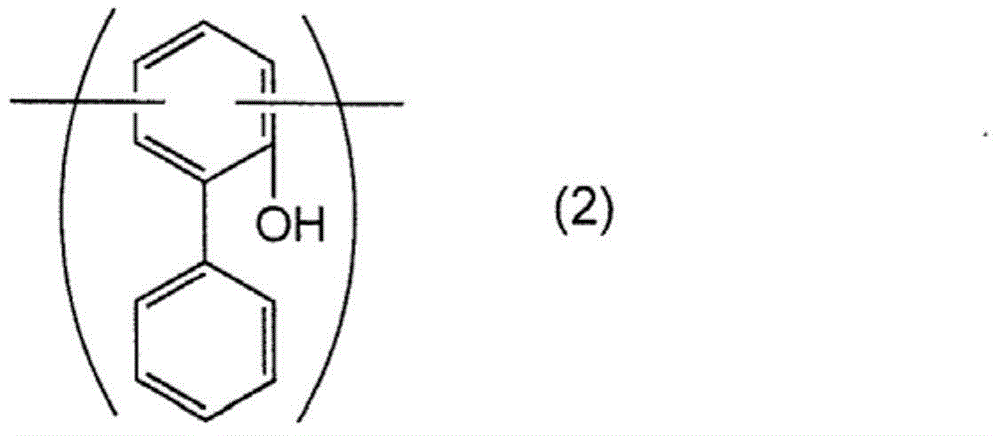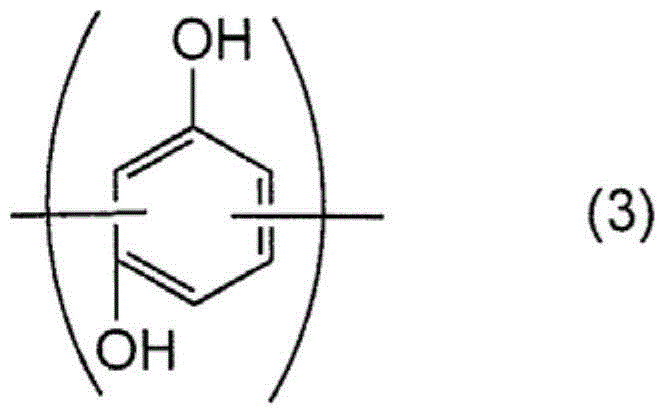Cocondensate and method for producing same, and rubber composition containing cocondensate
A manufacturing method and co-condensation technology, which are applied in the field of co-condensates and their manufacture, and rubber compositions containing co-condensates, can solve problems such as use restrictions, and achieve the effects of suppressing evaporation and firm adhesion
- Summary
- Abstract
- Description
- Claims
- Application Information
AI Technical Summary
Problems solved by technology
Method used
Image
Examples
Embodiment
[0109] Hereinafter, the present invention will be described in more detail with examples and comparative examples, but the present invention is not limited thereto.
[0110] (1) Production example and physical property evaluation of cocondensate
[0111] The analysis and physical property evaluation of the cocondensate were performed as follows.
[0112] a) Determination of the average molecular weight of the cocondensate
[0113] The average molecular weight of the cocondensate was calculated as a polystyrene-equivalent weight average molecular weight by gel permeation chromatography (GPC) analyzed using the following apparatus and conditions.
[0114] · Equipment used: HLC-8220GPC (manufactured by Tosoh),
[0115] ・Column: TSK guard column SUPERHZ-L (manufactured by Tosoh)
[0116] +TSK-GELSUPERHZ1000
[0117] +TSK-GELSUPERHZ2500
[0118] +TSK-GELSUPERHZ4000
[0119] ·Column temperature: 40℃,
[0120] ・Injection volume: 10μL,
[0121] Carrier liquid and flow ra...
Embodiment 2
[0155] In Example 1, the addition amount of p-tert-butylphenol was changed to 15.0 g (0.10 mol), and the addition amount of o-phenylphenol was changed to 85.0 g (0.50 mol). By operation, 177 g of an orange cocondensate was obtained.
[0156] Average molecular weight of the cocondensate: 2160; softening point of the cocondensate: 123°C; residual toluene percentage in the cocondensate: 1.1%; residual p-tert-butylphenol percentage: 0.0%; residual o-phenylphenol percentage: 0.4 %; residual resorcinol percentage: 9.5%. The ratio of each structural unit of the cocondensate: o-phenylphenol: 5.40; methylene: 1.33.
[0157]
[0158] 43.5g (1.33mol) of paraformaldehyde with a purity of 92%, 150g (1.00mol) of p-tert-butylphenol, and 75.0g of toluene were successively added to a four-neck detachable flask with a reflux condenser and a thermometer. Then, it heated up to internal temperature 45 degreeC, 4.16g (0.05mol) of 48% sodium hydroxide aqueous solution was added, and it stirred u...
Embodiment 3
[0162]Add 90.0g (1.11mol) formalin with a purity of 37%, 15.0g (0.10mol) p-tert-butylphenol, 85.0g (0.50mol) o-Phenylphenol. Then, it heated up to internal temperature 45 degreeC, 20.0g (0.12mol) of 24% sodium hydroxide aqueous solution was added, and it stirred until heat generation ceased. After confirming that the heat generation had ceased, the temperature was raised to 65° C. at the inner temperature, and the temperature was kept at the same temperature for 1.5 hours. Then, the temperature was raised again to an internal temperature of 75° C., and the temperature was further maintained for 3 hours.
[0163] After the reaction was terminated, it was cooled to an internal temperature below 65° C., and 77.0 g of methyl isobutyl ketone was added for dilution. Then, the reaction solution was neutralized, stirred for 10 minutes, and left to stand to remove the water layer.
[0164] 69.3 g (0.63 mol) of resorcinol was added, the temperature was raised to 100° C., and the mixt...
PUM
| Property | Measurement | Unit |
|---|---|---|
| softening point | aaaaa | aaaaa |
| softening point | aaaaa | aaaaa |
| softening point | aaaaa | aaaaa |
Abstract
Description
Claims
Application Information
 Login to View More
Login to View More - R&D
- Intellectual Property
- Life Sciences
- Materials
- Tech Scout
- Unparalleled Data Quality
- Higher Quality Content
- 60% Fewer Hallucinations
Browse by: Latest US Patents, China's latest patents, Technical Efficacy Thesaurus, Application Domain, Technology Topic, Popular Technical Reports.
© 2025 PatSnap. All rights reserved.Legal|Privacy policy|Modern Slavery Act Transparency Statement|Sitemap|About US| Contact US: help@patsnap.com



